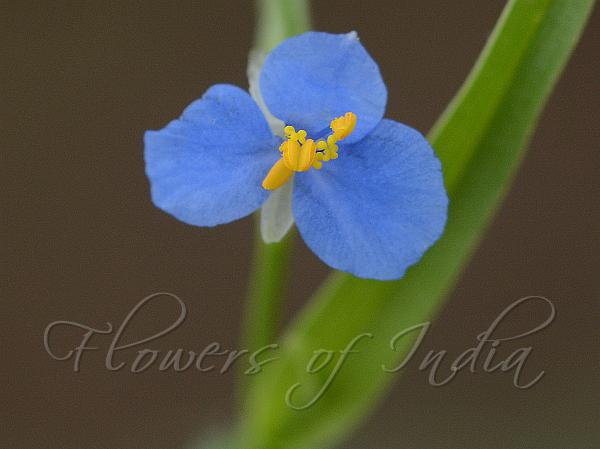|
| Badami Dayflower |
|

|

| File size | 840140 |
| Original date | 8/28/17 8:46 PM |
| Resolution | 2048 x 1536 |
| Flash | Flash did not fire, auto |
| Focal length | 90.0mm |
| Exposure time | 1/500s |
| Aperture | 6.3 |
| Focus Distance | |
| Metering Mode | Spot |
| Camera make | NIKON CORPORATION |
| Camera model | NIKON D7100 |
| Sensor type | OneChipColorArea |
|
|
|
|
Photo: |
Botanical name: Commelina badamica Family: Commelinaceae (Dayflower family)
Badami Dayflower is an annual herb, diffusely
branched, about 30 cm tall, ascending to erect, with or without
definite growth. It is named for Badami, a tourist destination in
Karnataka. Flowers are 1-1.2 cm across, dark blue in color, rarely
white, flower-stalk about 5 mm, hairless. Lateral sepals are paired,
elliptic, about 4 mm long, 2 mm wide, petaloid or faint blue to white,
concave at tip; medial sepal slightly to broadly elliptic, about 4 mm
long, 3 mm wide. Lateral petals are paired, clawless or rarely with
inprominent claw, limb round to sub-round, about 6 mm long, 6 mm wide,
dark blue, medial petal nearly-round, about 5 mm long, 4 mm wide, dark
blue, rarely white. Badami Dayflower is similar to
Willow Leaved Dayflower, but
differs in having an indefinite habit, linear to narrowly lanceshaped
leaves, finely velvet-hairy, velutinous to woolly spathes, upper
cincinnus with single male flower, clawless petals, yellow to golden
yellow antherodes, velutinous ovary, radiately tri-lobed stigma, single
capsule per spathe, spathe with rounded or retuse tip, oblique base,
and prominent mid-ventral constriction, and trapezoidal, ventrally flat
seeds. Badami Dayflower is found on sandstone plateaus of the Bagalkot
and Gadag districts of Karnataka and is possibly endemic to this
region. Flowering: October-December.
| Identification credit: Mayur Nadikar, Jagdish Dalvi | Photographed in Mahukuteshwer, Badami, Karnataka. |
• Is this flower misidentified? If yes,